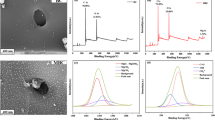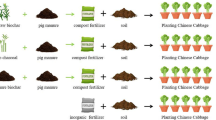Abstract
The effect of two different biochar types, rice straw biochar (RSB) and mushroom biochar (MB), on chicken manure composting was previously examined by monitoring the fate of antibiotic resistance genes (ARGs) and arsenic. The behavior of ARGs and arsenic in other kinds of manure composting with the same biochar types had not been examined. In this study, we added either RSB or MB to pig and duck manure composts to study the behavior of ARGs (tet genes, sul genes, and chloramphenicol resistance genes) and arsenic under the same experimental condition. The results showed that the average removal values of selected ARGs were respectively 2.56 and 2.09 log units in duck and pig manure compost without the addition of biochar. The effect of biochar addition on the average removal value of ARGs depended on the type of biochar and manure. For instance, in pig manure compost, MB addition increased the average removal value of ARGs, while RSB addition decreased. And both biochar additions had a negative influence on the average removal value of ARGs in duck manure compost. Analytical results also demonstrated that MB addition reduced total arsenic and the percentage of bioavailable arsenic more than RSB.



Similar content being viewed by others
References
Agegnehu G, Bass AM, Nelson PN, Muirhead B, Wright G, Bird MI (2015) Biochar and biochar-compost as soil amendments: effects on peanut yield, soil properties and greenhouse gas emissions in tropical North Queensland, Australia. Agric Ecosyst Environ 213:72–85
Amir S, Hafidi M, Merlina G, Revel JC (2005) Sequential extraction of heavy metals during composting of sewage sludge. Chemosphere 59:801–810
Baker-Austin C, Wright MS, Stepanauskas R, McArthur JV (2006) Co-selection of antibiotic and metal resistance. Trends Microbiol 14:176–182
Chang KL, Wang XD, Li M, Xing ZJ, Peng YP, Wang Y (2013) Chemical and physical properties of biochar produced from spent mushroom substrate. 2013 International Conference on Frontiers of Environment, Energy and Bioscience (ICFEEB 2013), Beijing, People's Repbulic of China. DEStech Publications, Inc, USA, 604-608
Chen H, Zhang MM (2013) Occurrence and removal of antibiotic resistance genes in municipal wastewater and rural domestic sewage treatment systems in eastern China. Environ Int 55:9–14
Cheng WX, Chen H, Su C, Yan SH (2013) Abundance and persistence of antibiotic resistance genes in livestock farms: a comprehensive investigation in eastern China. Environ Int 61:1–7
Cui EP, Wu Y, Zuo YR, Chen H (2016) Effect of different biochars on antibiotic resistance genes and bacterial community during chicken manure composting. Bioresour Technol 203:11–17
Department of Rural and Urban Construction and Environmental Protection, People’s Republic of China (1985) Control standards for pollutants in sludges from agricultural use. GB4284–84 (in Chinese)
Duan ML, Li HC, Gu J, Tuo XX, Sun W, Qian X, Wang XJ (2017) Effects of biochar on reducing the abundance of oxytetracycline, antibiotic resistance genes, and human pathogenic bacteria in soil and lettuce. Environ Pollut 224:787-795
He LY, Ying GG, Liu YS, Su HC, Chen J, Liu SS, Zhao JL (2016) Discharge of swine wastes risks water quality and food safety: antibiotics and antibiotic resistance genes from swine sources to the receiving environments. Environ Int 92-93:210–219
He LY, Liu YS, Su HC, Zhao JL, Liu SS, Chen J, Liu WR, Ying GG (2014) Dissemination of antibiotic resistance genes in representative broiler feedlots environments: identification of indicator ARGs and correlations with environmental variables. Environ Sci Technol 48:13120–13129
Hou QH, Ma AZ, Lv D, Bai ZH, Zhuang XL, Zhuang GQ (2014) The impacts of different long-term fertilization regimes on the bioavailability of arsenic in soil: integrating chemical approach with Escherichia coli arsRp::luc-based biosensor. Appl Microbiol Biotechnol 98:6137–6146
Huang M, Zhou S, Sun B, Zhao Q (2008) Heavy metals in wheat grain: assessment of potential health risk for inhabitants in Kunshan, China. Sci Total Environ 405:54–61
Jia SY, Shi P, Hu Q, Li B, Zhang T, Zhang XX (2015) Bacterial community shift drives antibiotic resistance promotion during drinking water chlorination. Environ Sci Technol 49:12271–12279
Muhammad N, Dai ZM, Xiao KC, Meng J, Brookes PC, Liu XM, Wang HZ, Wu JJ, Xu JM (2014) Changes in microbial community structure due to biochars generated from different feedstocks and their relationships with soil chemical properties. Geoderma 226:270–278
Paz-Ferreiro J, Lu H, Fu S, Mendez A, Gasco G (2014) Use of phytoremediation and biochar to remediate heavy metal polluted soils: a review. Solid Earth 5:65–75
Poulsen PH, Moller J, Magid J (2008) Determination of a relationship between chitinase activity and microbial diversity in chitin amended compost. Bioresour Technol 99:4355–4359
Pruden A, Pei R, Storteboom H, Carlson KH (2006) Antibiotic resistance genes as emerging contaminants: studies in northern Colorado. Environ Sci Technol 40:7445–7450
Puga AP, Abreu CA, Melo LC, Beesley L (2015) Biochar application to a contaminated soil reduces the availability and plant uptake of zinc, lead and cadmium. J Environ Manag 159:86–93
Qian MR, Wu HZ, Wang JM, Zhang H, Zhang ZL, Zhang YZ, Lin H, Ma JW (2016) Occurrence of trace elements and antibiotics in manure-based fertilizers from the Zhejiang Province of China. Sci Total Environ 559:174–181
Sanchez-Garcia M, Alburquerque JA, Sanchez-Monedero MA, Roig A, Cayuela ML (2015) Biochar accelerates organic matter degradation and enhances N mineralisation during composting of poultry manure without a relevant impact on gas emissions. Bioresour Technol 192:272–279
Selvam A, Xu DL, Zhao ZY, Wong JW (2012) Fate of tetracycline, sulfonamide and fluoroquinolone resistance genes and the changes in bacterial diversity during composting of swine manure. Bioresour Technol 126:383–390
Shen ZT, Jin F, Wang F, McMillan O, Al-Tabbaa A (2015) Sorption of lead by Salisbury biochar produced from British broadleaf hardwood. Bioresour Technol 193:553–556
Shen ZT, Som AM, Wang F, Jin F, McMillan O, Al-Tabbaa A (2016) Long-term impact of biochar on the immobilisation of nickel(II) and zinc(II) and the revegetation of a contaminated site. Sci Total Environ 542:771–776
Smalla K, Heuer H, Gotz A, Niemeyer D, Krogerrecklenfort E, Tietze E (2000) Exogenous isolation of antibiotic resistance plasmids from piggery manure slurries reveals a high prevalence and diversity of IncQ-like plasmids. Appl Environ Microbiol 66:4854–4862
Speer BS, Shoemaker NB, Salyers AA (1992) Bacterial resistance to tetracycline: mechanisms, transfer, and clinical significance. Clin Microbiol Rev 5:387–399
Stepanauskas R, Glenn TC, Jagoe CH, Tuckfield RC, Lindell AH, McArthur JV (2005) Elevated microbial tolerance to metals and antibiotics in metal-contaminated industrial environments. Environ Sci Technol 39:3671–3678
Strawn DG, Rigby AC, Baker LL, Coleman MD, Koch I (2015) Biochar soil amendment effects on arsenic availability to mountain brome. J Environ Qual 44:1315–1320
Su JQ, Wei B, Ou-Yang WW, Huang FY, Zhao Y, Xu HJ, Zhu YG (2015) Antibiotic resistome and its association with bacterial communities during sewage sludge composting. Environ Sci Technol 49:7356–7363
Wang C, Tu QP, Dong D, Strong PJ, Wang HL, Sun B, Wu WX (2014) Spectroscopic evidence for biochar amendment promoting humic acid synthesis and intensifying humification during composting. J Hazard Mater 280:409–416
Wang FH, Qiao M, Chen Z, Su JQ, Zhu YG (2015) Antibiotic resistance genes in manure-amended soil and vegetables at harvest. J Hazard Mater 299:215–221
Wang LL, Oda Y, Grewal S, Morrison M, Michel FJ, Yu ZT (2012) Persistence of resistance to erythromycin and tetracycline in swine manure during simulated composting and lagoon treatments. Microb Ecol 63:32–40
Xu N, Tan GC, Wang HY, Gai XP (2016) Effect of biochar additions to soil on nitrogen leaching, microbial biomass and bacterial community structure. Eur J Soil Biol 74:1–8
Xu HJ, Wang XH, Li H, Yao HY, Su JQ, Zhu YG (2014) Biochar impacts soil microbial community composition and nitrogen cycling in an acidic soil planted with rape. Environ Sci Technol 48:9391–9399
Ye M, Sun MM, Feng YF, Wan JZ, Xie SN, Tian D, Zhao Y, Wu J, Hu F, Li HX, Jiang X (2016) Effect of biochar amendment on the control of soil sulfonamides, antibiotic-resistant bacteria, and gene enrichment in lettuce tissues. J Hazard Mater 309:219–227
Yin YN, Gu J, Wang XJ, Song W, Zahng KY, Sun W, Zhang X, Zhang YJ, Li HC (2017) Effects of Copper Addition on Copper Resistance, Antibiotic Resistance Genes, and intl1 during Swine Manure Composting. Front Microbiol 8:344
Zhang YJ, Li HC, Gu J, Qian X, Yin YN, Li Y, Zhang RR, Wang XJ (2016) Effects of adding different surfactants on antibiotic resistance genes and intI1 during chicken manure composting. Bioresour Technol 219:545–551
Zhou LJ, Ying GG, Liu S, Zhang RQ, Lai HJ, Chen ZF, Pan CG (2013) Excretion masses and environmental occurrence of antibiotics in typical swine and dairy cattle farms in China. Sci Total Environ 444:183–195
Zhu YG, Johnson TA, Su JQ, Qiao M, Guo GX, Stedtfeld RD, Hashsham SA, Tiedje JM (2013) Diverse and abundant antibiotic resistance genes in Chinese swine farms. Proc Natl Acad Sci USA 110:3435–3440
Acknowledgements
The authors thank the managers of pig and duck feedlots for providing the samples. This work was financially supported by the National Natural Science Foundation of China (21677121 and 41571130064).
Author information
Authors and Affiliations
Corresponding author
Ethics declarations
Conflict of interest
The authors declare that they have no competing financial interest.
Additional information
Responsible editor: Robert Duran
Electronic supplementary material
ESM 1
(DOC 301 kb)
Rights and permissions
About this article
Cite this article
Cui, E., Wu, Y., Jiao, Y. et al. The behavior of antibiotic resistance genes and arsenic influenced by biochar during different manure composting. Environ Sci Pollut Res 24, 14484–14490 (2017). https://doi.org/10.1007/s11356-017-9028-z
Received:
Accepted:
Published:
Issue Date:
DOI: https://doi.org/10.1007/s11356-017-9028-z




